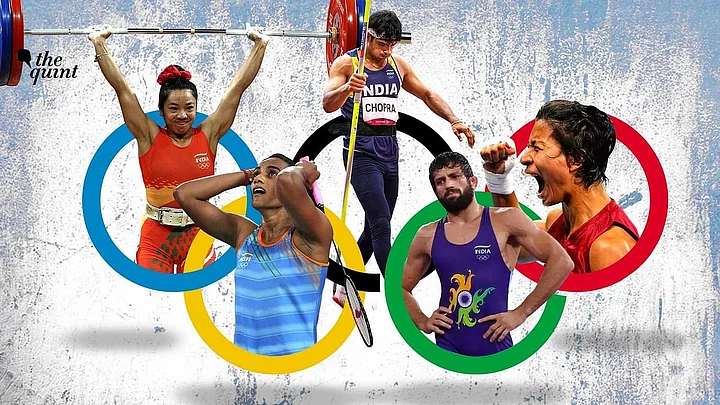Call them the dazzling dozen. The 12 athletes who are being awarded the Khel Ratna this year are some of our best; produced through a relentless journey of passion, determination, and discipline.
The result of an enduring effort that does not spare mind or muscle.
The ministry of youth affairs and sports turned prolific this year, awarding the Major Dhyan Chand Khel Ratna award to an unprecedented number of 12 athletes, including five Paralympians – Avani Lekhara, Sumit Antil, Pramod Bhagat, Krishna Nagar and Manish Narwal.
While the first double issue way back in 2002 invited plenty of scorn and criticism, the Khel Ratna has been awarded to multiple athletes in 2009, 2012, and every year since 2016.
But now, with 12 being awarded this year, there have been some murmurs of agony at the potential dilution of the biggest honour for sport in India. Instead, it might serve us better to appreciate the growing appreciation for sport in India.
After suffering secondary existence for decades after independence, sport in India is finally emerging into its own as a pursuit worthy of our respect and adulation. Perhaps, the fact that nearly half of the awardees are Paralympians reflects a growing ability of the Indian society at large to embrace our differences and acknowledge myriad expressions.
The first two decades of this millennium have marked a cultural shift, driven by a spirit of inclusiveness and understanding. Indians, all the way from Kashmir to Kanyakumari and the land and ocean that lay between Lakshadweep and Andaman are finally beginning to view sport as a pursuit of excellence, integral to the education and existence of human beings.
We could debate passionately till the chickens return home to roost, about who deserves the Khel Ratna award this year but there is no doubting the need to acknowledge excellence in the realm of sport, and doing so with steady faith.
And 47 recognitions, including the Arjuna Awardees, might only serve to inspire the younger generation of athletes to even greater heights. Especially those who are in the crosshairs of development, where they are pushed to make important decisions about the direction of their lives.
Somewhere deep in some unsung field, a young child thrusts the newspaper in the hands of her parent, making the case for her own pursuit. These awards can offer a much-needed empirical argument for that young girl to convince her family to support her pursuit, away from the arc lights, soaked in the grime of daily effort.
Neeraj Chopra attained immortality, riding his soaring javelin. 87.58 is a number that has pierced into the collective conscience of a slumbering giant. He did not need an advocate to make his case.
Ravi Kumar and Lovlina Borgohain embodied the modern spirit of India, all of 75 as an independent geo-political entity and eager to break away from its colonial inhibitions. They stretched their resources, believed in themselves, and stuck to their task with a missionary zeal to mint metal to decorate their Olympic journey.
India won seven medals at the Tokyo Olympics. The provisions of the Khel Ratna provide for a significant chunk of points for Olympic success, ahead of the World Championships, Asian Games, and Commonwealth Games. It was only to be expected that some of these heroes would be rewarded for their success.
PR Sreejesh is a wall in the goal for Indian hockey and a leader within the team. His spirit and an acute awareness of the fine details of hockey have served the team for longer than most can remember. He would have perhaps received the Khel Ratna even without the heroic efforts in Tokyo.
Manpreet was already an Arjuna Awardee, and with his entire team now receiving the recognition, the ministry had to find a way to acknowledge the man who lead from the front. He did a terrific job shepherding his team over the past few years. Hardly anyone can begrudge his elevation to the Khel Ratna this time around, purely for providing the inspiration needed to forge his steely band of warriors.
It is rare for exaggeration to sound mundane. But that is indeed the case with both Mithali Raj and Sunil Chhetri. Perhaps, they honour the award far more than the other way around. Mithali and Sunil have been at the forefront of their respective sports for the past two decades, holding the fort for their teams. Even more significantly, they hold acclaimed standards in their respective sports, towering head and shoulders over their peers.
These awards recognise heroes, men and women, who have strained their every last sinew to taste the elixir of excellence. Their efforts have elevated our flag and honoured our anthem. Their performance and the recognition that has followed will fuel belief, passion, and effort, perpetuating the production line for excellence in India, in sport and beyond.
The most prolific acknowledgment of our Paralympians reflects a shifting attitude not only in sport, but also in life. India remains notoriously inaccessible for people with disabilities. It is very common for Indian towns to present themselves with a set of expansive arches and stairs, insensitively ignorant of the needs of not only the disabled, but also the elderly.
Acknowledging five Paralympians provides a uniquely powerful platform for much needed conversations on building a more inclusive society. Pramod, Avani, and Sumit have already shown their ability to speak up for the community. Their success and continued recognition is bound to expand their world of opportunities and the class of '21 is bound to leave a deeper imprint on our collective conscious in the years to come.
The Khel Ratna has a unique appeal in Indian hearts and the sporting fraternity. While the Arjuna Award is indeed a special recognition and culturally significant, the Khel Ratna is a uniquely powerful accomplishment. Acknowledging a dozen of our very best will only add to its enduring lustre.
(At The Quint, we question everything. Play an active role in shaping our journalism by becoming a member today.)
